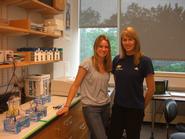
In a small lab on the second floor of the Science Center, two identical-looking vials of specimens sit side by side, waiting to be processed. But although the samples may appear to be the same, they were collected from almost opposite sides of the Earth: Green Lake in Fayetteville, N.Y., and Antarctica’s Hughes Bay. Working under Associate Professor of Biology Michael McCormick, Libby Pendery ’10 and Agne Jakubauskaite ’13 are using similar methods of analysis on samples from two very different locations to meet a common goal: detect and classify the species of microbes that are present at different depths.
Like the students working with Professor of Biology Jinnie Garrett, Pendery and Jakubauskaite are continuing the work on Green Lake. Green Lake is a meromictic lake, which means that its layers do not undergo seasonal overturn and remain static year-round, unmixed and distinct like the layers in a layer cake. Each depth in the lake corresponds to different conditions; the water has varying concentrations of chemical components (such as oxygen, sulfur, carbon dioxide and methane), different temperatures, and more or less exposure to sunlight depending on its depth. Both research teams are working to determine what types of microorganisms live at each level of the lake and why the conditions at that depth favor that microorganism’s survival.
While Garrett’s team is focusing more on the fungi in the lake, Pendery and Jakubauskaite are analyzing the archaea and bacteria compositions. For her senior thesis in biology this past year, Pendery examined the different bacteria in Green Lake, correlating the qualities of the organisms’ habitat to the reasons why the organisms thrive in such populations under those specific conditions.
At the beginning of the spring semester, Professor McCormick traveled to Antarctica with a team of scientists. He found his way to Hughes Bay, a bay on the western coast of the Antarctic Peninsula. He sampled ice cores and also drew sediment samples from various depths in the lake, plunging as deep as 530 meters below the water’s surface. Like with the samples from Green Lake, Pendery and Jakubauskaite are in the process of determining the types of organisms that exist at different depths in Hughes Bay. With both sets of samples, they first run the samples through a polymerase chain reaction (PCR) to identify the presence of archaea or bacteria, then perform gel electrophoresis to confirm the presence of the suspected type of microorganism.
The team is only beginning its analysis of the Hughes Bay samples, but they believe they have already identified the presence of both archaea and bacteria at the highest depth and the lowest depth, and they will continue to test for the presence of these organisms in between. “Just the fact that there’s archaea and bacteria in such inhospitable conditions is interesting,” Pendery said. “I’m happy just to see that [the organisms are] there because we weren’t sure that they would be.” In the future, the research team hopes to find out if different types of archaea and bacteria are present in the samples and, if so, how the organisms are able to live under such extreme conditions.
“It’s cool to be using the same procedures on samples from both Green Lake and Antarctica,” Pendery said. “To some extent you’re finding the same thing, but you can find out that they’re really so different. The most interesting part is finding what kinds of bacteria live in these areas and how they’re surviving.”
After spending last summer as well as the academic year working with Professor McCormick, Pendery is glad to be able to bring closure to a project on which she has spent so much time and energy. At the end of the summer, Pendery will pursue her passion for public health by working with Message Global in Washington, D.C., which focuses on global health, global development, and environmental sustainability.
An international student from Lithuania, Jakubauskaite is enjoying her first summer at Hamilton and hopes to continue doing research in future summers. “I’m really glad Libby’s around to teach me,” Jakubauskaite laughed. “I feel like I’ve learned more in the past three weeks than I have in an entire year of lab because I get to do everything myself.”
Pendery is a graduate of the Out of Door Academy in Sarasota, Fla., and Jakubauskaite graduated from the Panevezio Secondary School in her hometown of Panevezys, Lithuania.
Posted July 9, 2010
